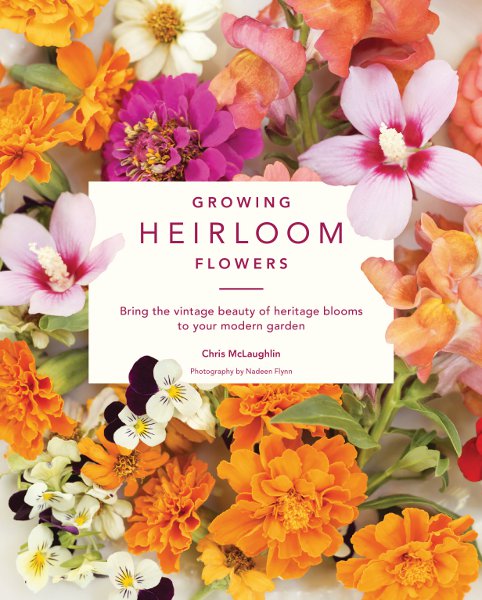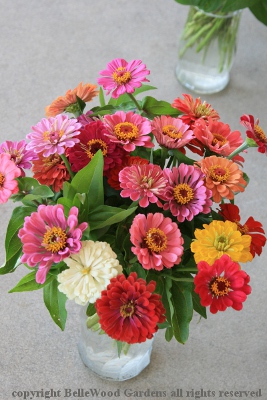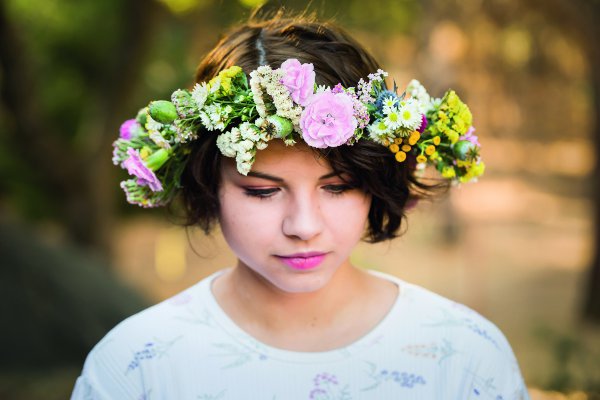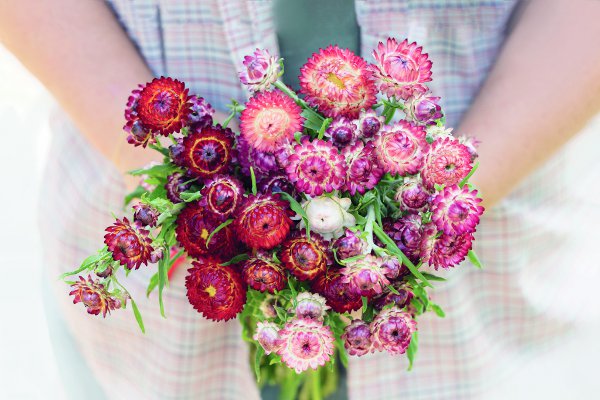
.
If you have any comments, observations, or questions about what you read here, remember you can always Contact Me
All content included on this site such as text, graphics and images is protected by U.S and international copyright law.
The compilation of all content on this site is the exclusive property of the site copyright holder.
Growing Heirloom Flowers:
Bring the Vintage Beauty of Heritage Blooms to Your Modern Garden
by Chris McLaughlin, author, and Nadeen, Flynn photographer
Sunday, 22 July 2018
These days it seems that every time I look online - at the news, on a gardening site, even emails from a friend - there is something about GMO, genetically modified organisms. Roundup resistant corn and soybeans. The other day someone in the grocery store was looking for mayonnaise. Even the one labeled olive oil had soybean oil in it. Which likely is GMO, which she wanted to avoid. I asked if she had a food processor. Yes. Then, I told her, make your own mayonnaise. But I digress. Freeze resistant strawberries, with fishy genes. Goats with spider genes, so their milk can be used to create threads stronger than kevlar.
People have been manipulating plants and animals for a very long time. Mules, a cross between a female horse and a stallion donkey. Mules cannot make more mules because they are sterile. Hybrid corn, created by crossing two distinct strains. Cannot save seed from the hybrid corn because it will not come true. Oh, you'll get corn, but it will be something like the parent strains or something somewhere between.
Some gardeners are looking back to heirloom animals and plants. Are you one? Then Growing Heirloom Flowers: Bring the Vintage Beauty of Heritage Blooms to Your Modern Garden written by Chris McLaughlin with photography by Nadeen, Flynn could be the book for you.

"First," says my husband the engineer, "define your terms." O.K. So what is an heirloom plant. We've already decided it is open-pollinated, something that will breed true. But after that there are some differences of opinion. Chris McLaughlin explains that many agree that "heirloom" refers to plants that have been cultivated for 50 to 100 years. Some prefer to use 1951 as a cut off, when large commercial seed companies began seriously marketing hybrid seed. But there are even older outliers, such as hybrid roses dating back to 1867. Or perennials such as the Japanese anemone 'Honorine Jobert' which was introduced in 1858.

© BelleWood Gardens
Anemone 'Honorine Jobert'
Why grow heirloom plants? Fragrance could be one reason. In the quest for bigger / more vivid / double / whatever flowers fragrance often gets short shrift. Older roses are quite often more fragrant than modern cultivars. Then, Chris notes that heirlooms are easy keepers. Perhaps most of the time, but not always. Heirloom varieties of garden flowers such as summer phlox and beebalm are prone to mildew. Newer cultivars have been bred and selected for resistance to this summer bane.

© BelleWood Gardens
Beebalm with mildew
Did you know that plants can be patented? They must be selected from a garden, have distinct attributes, and propagated asexually by cuttings, division, or some other cloning technique. Heirlooms are different. As Chris also mentions, heirlooms are passalong plants, the kind that are shared among friends from garden to garden, or found on the table at garden club plant sales. Whether an envelope of seeds or a division of a perennial, these heirlooms are plants that are easy to share. Just remember what my friends from Down South taught me. "Mama said don't thank for plants. If you do, they won't grow."
There's also a sidebar about invasive plants and toxic plants. A plant that might be mannerly and well behaved in one part of the country can be over-enthusiastic somewhere else. It is also good to remember that small children and pets can chew on whatever they find, so be careful with what grows in your garden if small people and pets are also there.
Done with these generalities, Growing Heirloom Flowers now moves on to some specific: Bold Blooms for the Cutting Garden, with a dozen annuals and perennials from dahlias to zinnias, and even a shrub (hydrangea). Each entry provides some background but more importantly, cultivation tips and techniques. A separate section discusses the details of cutting and preparing flowers for the vase from when to cut each of the flowers mentioned, floral preservatives, and a suggestion to keep cut flowers away from fruit because the ethylene gas from ripening fruit causes flowers to wilt. I hear this about flower bulbs in the refrigerator too, but that's a closed space. A room, especially if there is an open window . . . seems unlikely.

© BelleWood Gardens
Farm stand zinnias
I confess my flower arranging skills are more along the lines of stuff them in a vase and hope things don't fall over (with or without some help from my cats.)

photography by Nadeen Flynn
There is one page with basic principles of flower arranging complete with some simplified line drawings on how to create a diversity of arrangements, and a page of quickie tips.

photography by Nadeen Flynn
Suggestion for making a summer flower crown,
with directions in a later section.
Heirloom flowers are the ones Chris reccomends for their delicious scent. The next section of the book is about Flowers for Fragrance: beebalm, flowering tobacco, heliotrope, lilac, peony, phlox, pinks (dianthus),stock, and sweet peas. Again there's a description of each with a snippet of background and more about growing. Craft instructions include making May Day baskets and making a sweet little tussie mussie bouquet. There is also an extensive section on lavender. It makes sense because lavender is so fragrant. But it is also odd because lavender is not discused until the following section of the book.

photography by Nadeen Flynn
Information is provided on how to dry and store lavender.
This is followed by a page listing a great number of suggestions for using lavender: baked goods, jams and jellies, lemonade, essential oils, bathtub soak, body products, candles, heating pads, eye pillows, household cleaners, wands, lavender water, linen water, sachets, shampoo, soap, loose-leaf tea, décor (wreaths, hanging bundles, potpourri) but no instructions on how to create any of these. You'll need another book with a focus on herbal crafts. Many are quite easy.

© BelleWood Gardens
Stages in making a lavender wand
There are other crafts that make use of flowers and you'll find them here in the The Handcrafter's Heirlooms section, along with the English lavender. They range from calendula to immortelles like globe amaranth, statice, strawflower

photography by Nadeen Flynn
A bouquet of strawflowers
and honesty (aka lunaria or money plant), love-in-a-mist (some years ago I learned that the seeds of nigella are the black caraway sprinkled on rye bread), marigold, and rose of sharon. Chris also has a list of other, also very vintage well-loved plants such as four o'clock, lily of the valley, bearded iris, hyacinth and a dozen more that also deserve a shout-out but there wasn't room to include a full profile on them.
Crafts range from pressed or dried flowers to flower pounding and handmade floral paper. There's mention of body scrubs, bath salts, lotions, and artisan soaps, with a 2 page spread on how to make a rose and lavender body scrub. Tussie mussies are again mentioned here, as are flower crowns, and readers are advised to go back to Chapter 2 for directions. Some more suggestions on home décor and candles, but much more on natural flower dyes with a 4 page spread on how to create a marigold-dyed silk scarf.
Cottage Classics are the heirloom flowers that wrap up our options, a bagatelle from balloon flower, black-eyed Susan, bleeding heart, blue flax, clematis, cornflower (considered invasive in some states, Chris mentions) to cosmos, daffodil, echinacea, forget-me-not, kiss-me-over-the-garden-gate (Persicaria orientalis), love-lies-bleeding (Amaranthus caudatus) to morning glory and pelargonium. Grow them in the garden and use them as essentials for a garden party

photography by Nadeen Flynn
from a little flower bouquet for napkins
to directions on how to make frozen flower ice cubes and some drink recipes: a smoothie, a cocktail, and a simple syrup with roses or lavender. Here is where you'll find directions on how to frame the pressed flowers you made in the previous chapter, and suggestions on creating a Victorian garden journal.
Resources at the back of the book include sources / get your heirlooms here, heirloom flower gardens to visit, and good reads / bibliography.
There is only so much that can be included between the covers of any book. Growing Heirloom Flowers is a pleasant book that does well with what it covers but cannot quite decide if it wants to be a gardening book or a craft book.
Growing Heirloom Flowers is published by Cool Springs Press,
an Imprint of The Quarto Group, Minneapolis, MN 55401, 2018
ISBN: 978-0-7603-5939-6
A review copy of this book was provided by the publisher.
Back to Top
Back to Book Reviews 2018
Back to July 2018
Back to the main Diary Page